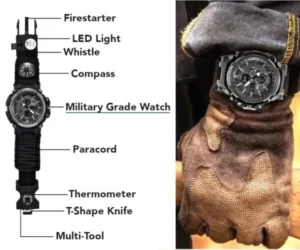When summer arrives, many of us want to cool off by taking a dip in the pool. But if you’re a watch-wearer, you might be wondering if it is safe to bring your timepiece with you.
In this article, we will discuss whether or not it is okay to wear a watch in the pool and how to protect your watch from water damage.

Understanding the water resistance rating of your watch:
The water resistance rating of a watch is a crucial factor to consider when wearing it in the pool. It indicates the level of protection the watch offers against water ingress and is typically expressed in meters or ATM (atmospheres). Familiarize yourself with the specific rating of your watch to understand its limitations.
For example, a 50-meter water resistance rating means it can withstand splashes and brief immersion but may not be suitable for prolonged water exposure or swimming. Understanding the rating helps you make informed decisions about wearing your watch in the pool and ensures its longevity.
Factors to consider when wearing your watch in the pool:
Several factors should be considered when wearing your watch in the pool. Firstly, confirm that your watch’s water resistance rating is suitable for pool activities. Additionally, factors like water temperature, pool chemicals (such as chlorine), and the intensity of your water activities play a role.
Prolonged exposure to chlorinated water or extreme temperature changes can affect the watch’s seals and overall performance. It’s important to assess these factors and ensure they align with the watch’s water resistance capabilities to prevent potential damage.
Best practices for wearing your watch in the pool:
To make the most of wearing your watch in the pool, follow these best practices. Firstly, ensure your watch has an appropriate water resistance rating for pool activities. Before entering the pool, ensure the crown is properly screwed down or pushed in to maintain a tight seal. Rinse the watch with freshwater after pool sessions to remove any chlorine or other chemicals that could potentially damage the watch.
Avoid pressing any buttons or operating the crown while the watch is submerged to prevent water from entering. Regularly inspect the watch for signs of water damage and adhere to manufacturer-recommended service intervals.
Alternatives to wearing a watch in the pool:
If you prefer not to wear a watch in the pool or want to protect your watch from potential water damage, there are alternative options available. One option is to use a dedicated waterproof sports watch or a swimming-specific smartwatch that offers enhanced water resistance features and specific swimming functionalities. These watches are designed to withstand prolonged water exposure and can provide accurate timekeeping during pool activities.
Another alternative is to use a waterproof or water-resistant fitness tracker or stopwatch specifically designed for swim tracking. These devices can provide the necessary functionalities without the risk of damaging your regular watch. Assess your needs and preferences to choose the best alternative option for your pool activities.
Conclusion
In conclusion, wearing a watch in the pool is generally safe as long as the watch is water-resistant and suitable for water activities. However, exposure to chemicals such as chlorine can affect the watch’s water resistance, so it is important to rinse the watch thoroughly with fresh water after use.
Following the manufacturer’s recommendations for usage and maintenance can help protect your watch from water damage and ensure it lasts for years to come.

